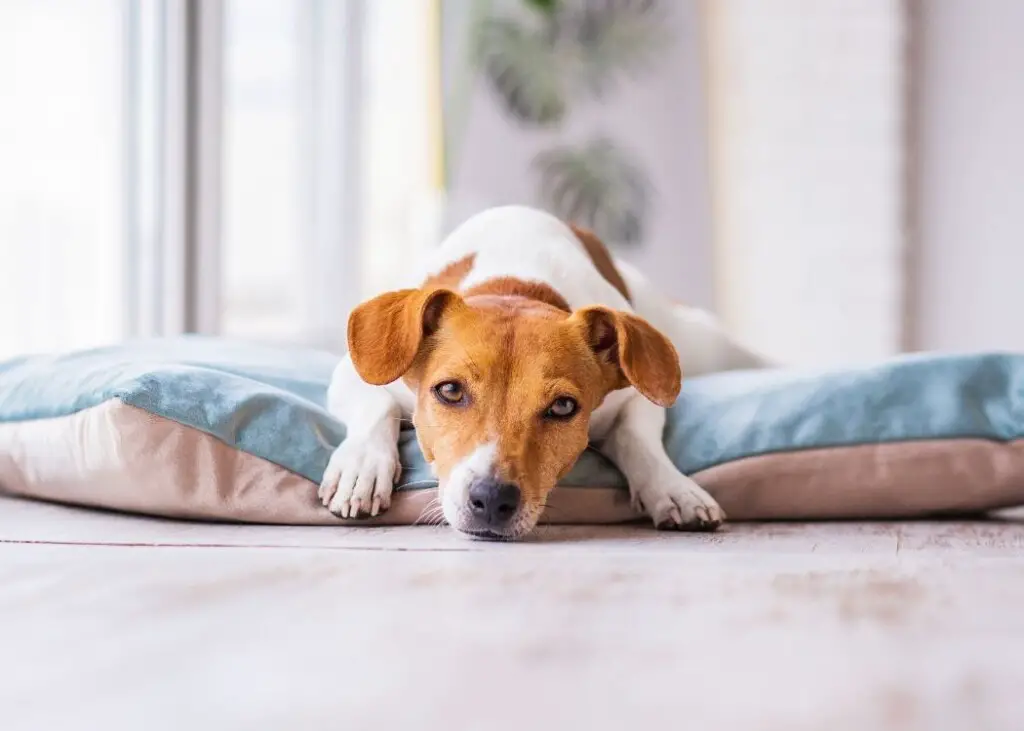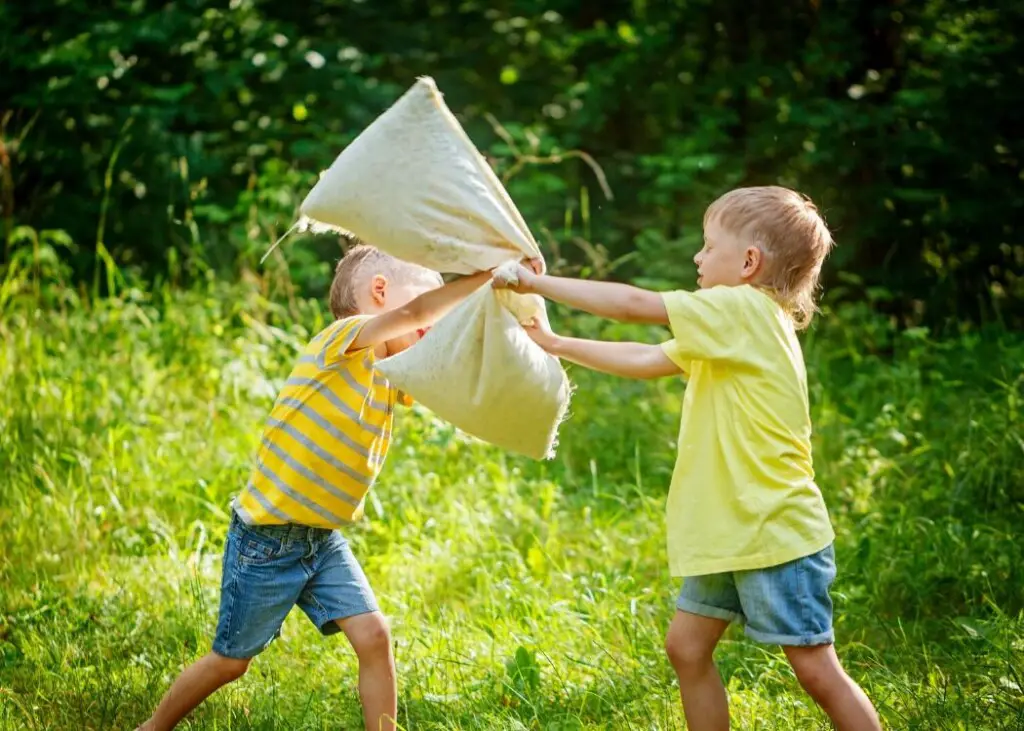Table of Contents
**This page contains affiliate links and I will be compensated if you make a purchase after clicking on my links**
18 Good (and 9 questionable) uses for old pillows and bedding.
You’re upgrading your bedding, or perhaps your old pillows simply flunked the “fold test”.
Obviously, you’ll save the extra (good) pillows for guests, but what do you do with all the rest.
Clean bedding, such as blankets, comforters, pillowcases, and sheets, can be donated to Goodwill®, the Salvation Army®, or your favorite shelter for either humans or animals.
This should be obvious, but…
Make sure all bedding items are thoroughly washed before donating
Used mattresses and pillows are icky
You probably already know that these groups will NOT take your old mattress. (They won’t even take a “new” mattress.)
This is understandable considering your mattress is filled with sweat, dead skin flakes, and “millions” of dust mites.
Dust mites are microscopic spider-like creatures that are more or less harmless. However, many of us are highly allergic to their poop.
>> For more on ridding your bedroom of these critters, see my post HERE.
Aside: the internet has been telling us that your average mattress has anywhere from 100,000 to a million dust mites. In addition, allegedly ten percent of the weight of a two-year-old pillow is composed of dust mites and their feces! Fortunately, these statistics are in dispute by the experts. But the point is the number is still “a lot”.
Unlike your bedding, you can’t throw your mattress into your washing machine and wash on hot.
If you purchase a new mattress, your old mattress can be taken away by the mattress delivery people. If not, you can call up your local garbage service and request a pickup. Either way, your old mattress most likely ends up in a landfill somewhere.
But back to pillows. Yes, they still are contaminated with your sweat, dead skin, and “a lot” of dust mites. But you can wash those.
Unfortunately, no one will take those either.
A charity doesn’t know if you’ve washed them thoroughly enough, on hot water above 130º F, or even at all.
They would need to sterilize the donated pillows themselves, which is not cost-effective.
What about your local animal shelter? Yes, they will welcome old sheets and blankets.
But they won’t take pillows. According to my local shelter: “dogs shred them, and they block the drains.”
(Even if you do have non-pillow bedding to donate, always call first to confirm their need.)
You may luck out with a cat-only shelter. You’ll need to call around.
If the pillows are in good shape, you may be able to ditch them at a garage sale or give them away to someone in your local community. Check your online community message boards.

Other uses for old pillows
So, what can you do with your pillow?
1. Pet bed
This only applies if you have a small non-pillow-chewing dog or a cat. And the cat will most likely prefer your current bed pillows because 1) they’re a cat, and 2) those pillows smell like their favorite human(s).
Some on the internet have suggested making a pet bed, then donating it to a shelter. However, if this shelter doesn’t want pillows, they probably don’t want pet beds either, for the same reason…
Call your local shelter first, before breaking out your sewing machine.
2. Recycle the stuffing for throw pillows
I have no qualms about throwing out an inexpensive pillow with common polyester fill. But what if the fill is nice down? Not prickly feathers sold as down, but real down.
Wash the down first, while it’s still encased in its original pillow. Most of the internet recommends warm water machine-washing for down. But in this case, go hot.
Don’t worry, sewing is not required.
Look for zippered throw pillowcases. You may stuff your down stuffing directly into the case, or instead pre-enclose it in a plain case first. This way you can switch out and wash an outer decorative case while leaving the stuffing alone within an inner case.
3. Recycle the stuffing for stuffed toys
Is Mister Bunny Face looking a bit anorexic? Fatten him up with more stuffing.
If Mister Bunny Face belongs to your child, make sure the stuffing is clean and hypoallergenic. No feathers if there’s a risk your child is allergic.
Better yet, first, give Mister Bunny Face a spa day in your hot washing machine.
4. Make casual throw pillows
Most of us do not live in an Architectural Digest-inspired formal living room. We’re very casual.
If the stuffing project above sounded like too much work, then simply place your old pillow in an attractive pillow sham and throw it on or around the sectional couch in your family room.
Or the playroom. Your human and furry children can enjoy a pillow fort!
Do your high-energy children (and adults) enjoy pillow fights? Now you have plenty of ammunition. (Machine-washed, dust-free pillows only.)
5. Restore old couch cushions
Perhaps that sectional couch in your casual family room has seen better days. Many of the cushions may have indentations where certain family members often sit.
You can boost up couch cushions by placing an old pillow underneath.
Better yet, for a more uniform look, remove the stuffing from the pillow, unzip the couch cushion and add stuffing to the underside.

6. Knee pillow for gardening
If you enjoy gardening, but don’t like hurting your knees (or getting grass stains) then kneel on an old pillow.
You could sew a clever case for it, but why bother. Use an old pillowcase instead.
7. Compost feathers
Speaking of gardening, feathers and other natural fills can be made into compost. Make sure you either cover them with other compost or soak them in water, as feathers can easily blow away in the wind.
8. Packing material
Out of all the bedding materials, foam makes the best packing material. Both regular and memory foam. If solid, you may cut it to size, or simply use shredded foam.
Note that other bedding materials are not as ideal, either because they compress, shift, or are simply too heavy.
Also, only use foam for short-term storage and shipping. Long term, your items need to stay dry and should, therefore, be packed in breathable materials.
(During my last move, the professional packers even avoided bubble-wrap. They used breathable paper only. Paper can be used either for wrapping or crumpled for padding.)
9. Block drafts
Shove your old pillow against a door or in front of a window.
Note that polyester and foam fills may not be particularly insulating. Down and feathers would work best here.
You may need to weigh down the pillow to keep it in place.
If you’re handy you can sew long “socks” and use the fill. But again, you’ll need to include something weighty, like sand, rice, or popcorn kernels, to keep it in place.
In the end, a simple scrunched up towel may work better as it will stay in place and fully cover the draft.
(The internet also suggests shoving a plastic-wrapped pillow up your chimney to block drafts. That sounds like an accident waiting to happen… Do at your own risk.)
Other uses for old blankets and sheets
Although these items are donatable, keep a few around for other purposes:

10. Picnic blanket
Keep a thin flannel sheet in your trunk for those days where you’d like to simply sit in the park and avoid grass stains. Keep several around for the kids who like to sit on the grass.
Any old sheet can also be used as a tablecloth on a public picnic table
11. Protective drop cloths
Planning a painting project? Thicker sheets and thin blankets can protect your floors or furniture from paint droppings.
If you are planning a renovation in part of your home, cover the furniture in the rest of your home with sheets to protect from dust.
Likewise, if you need to temporarily protect furniture from a visiting pet.
(If it’s your own pet, then you have most likely invested in polyurethane-containing waterproof covers as needed.)
Use an old sheet as a disposable tablecloth for the kids’ craft projects.
If you’re planning a move soon, don’t donate your old blankets just yet. They may be used to cover furniture to avoid bumping and scratching during transit.
12. Protect plants and outdoor planting beds
I live in sunny southern California, but I’m told in other parts of the country people need to wrap their plants to protect them from winter frost and weather. Or sometimes cover a planting bed during an especially chilly fall night.
13. Bedding storage
Old pillowcases make a great storage container for other bedding. Use a bit of rope or cord to tie it shut.
Most pillowcases have a double layer of fabric at the top or open end. If you’re handy, you can make a small hole here and thread the cord through the top of the case inside the fabric and back to the original hole. If there are seams in the way you simply make more holes and thread the cord outside and back in around the seam.
Voila, you have a drawstring bag!
If your pillowcases are cotton, keep in mind that these bags are for short-term or seasonal storage only. (See below.)
14. Repair patches
Keep an old white sheet on hand. Or better yet, an old sheet the same color and fabric as your new sheets. If you need to make a repair, you can cut off a slice of the old sheet to make a patch for the new sheet or piece of clothing.
Don’t worry, there are many ways to make a repair with no sewing. (However, an iron may be required.)
Likewise, if your sheets are in relatively good shape, they may be used for quilt backing or other sewing projects. Including plain cases for throw pillows, mentioned above.


15. Make a rag rug
This is a cool idea if you’re handy. Granted your old dingy-white sheets may only produce a mediocre bathmat, but there is potential here.
Dying your sheets a cool color and combining it with colorful fabric scraps will improve its appearance. Your old colored tee shirts can be added to the mix.
There are a lot of instructions online, but the gist is to cut your sheets into 1.5” strips. You can either use the strips as they are with unfinished edges or instead (after the step below) fold the unfinished edges towards the center and iron the strip so that the edges now appear finished.
Sew each of the strips together on their short ends so that you have one giant long strip. Roll the strip into a ball, just like you would with yarn.
No sewing machine? For a more “boho look” use a square knot to tie the ends of each strip together.
You can now treat this “yarn”, like any other type of yarn. You can braid it, weave it, knit it, or crochet it into a decorate mat or rug.
Have fun!
16. Ceiling fan duster
I keep fuzzy flannel pillowcases around just for this purpose. Ceiling fan blades get horrifically dusty. While your fan is off, one by one, place the case around each fan blade and rub to dust. This way the dust stays in the case and doesn’t fall on your head!
17. Blanket fort!
Add walls to the pillow fort you made above.
18. Toga party!
Are these a thing anymore? If not, let’s bring it back.
No? How about Greek-inspired cosplay?


Other (iffy) ideas from the internet
The internet has lots of ideas about what to do with old bedding. Some ideas are great (see above) and some are a bit questionable…
19. Restore an old pillow… with another old pillow
Yes, you can use the stuffing of one pillow to give new life to a second old pillow.
Does it pass the fold test? Fold the pillow in half. Does it immediately spring back open on its own or just sit there lifelessly?
Sure, this restoration idea is fine if you’re strapped for cash. But considering the importance of proper neck support, (especially for those of us entering our “arthritis” years) personally, I wouldn’t risk it.
Just buy a new pillow already.
20. Make curtains
Really? Cotton and linen wrinkle. More importantly, if your sheets are no longer “good enough” for your bed because they’re worn or torn, then they certainly aren’t good enough for curtains.
And there’s sewing required.
However, I will allow that they could make good blackout liners behind otherwise attractive curtains.
21. Shower curtain
Oh good, a shower curtain made of cotton that dries poorly and therefore encourages the growth of mold. Sign me up.
22. Wrap presents
Sure, but tape probably won’t work well to keep the wrapping in place. And again, would you like to receive a present wrapped in a worn sheet?
23. Cloth napkins
This involves sewing. And again, if your sheets are in poor shape, why?
24. Sleeping bag liner
So, you like to travel and stay in questionably clean hotels? We don’t judge.
A sleep sack is a very cost-effective solution. There’s no reason to pull out your sewing machine and old sheets.
For a sleep sack that is very lightweight, spend a bit more for silk. Keep in mind, these sleep sacks will NOT protect you from bedbugs, dust mites, and other icky things.
And if your camping outside in cool weather, a cotton liner is NOT recommended. It holds moisture (your sweat) making you feel cold and clammy.
25. Pipe insulation
As a temporary fix, sure. But really, hire a professional to wrap your pipes in material designed to insulate pipes. Do I need to remind you that condensation from pipes will lead to mildew in natural fibers?
26. Rags
Obviously. But at this point, you probably already have plenty from old towels and wash clothes. A single sheet could generate several lifetimes-worth of rags.
Yes, for many projects, especially painting projects, it’s useful to have many disposable rags on hand.
But for the most part, this won’t deplete your used bedding supply significantly.
27. Hamster bedding
In theory, the idea sounds good. Use some pillow fill in your hamster cage and throw it out once it gets soiled.
However, be very careful about what type of bedding you give to your beloved hamster. “Fluffy” materials such as cotton balls, cotton batting, felt and polyester fill are difficult to digest and can become a choking hazard. (Yes, your hamster tries to eat everything.)
Materials derived from plant fibers, including cellulose (eg, lyocell) should otherwise be ok.
There you have it. If your pillow is icky or uncomfortable don’t hesitate to upgrade. Potential neck and back problems aren’t worth it. Now you have a list of what to do with the old one.

Top photo credit: ©Unknown via Canva.com
Want to learn more about the products mentioned?
[If you experience issues with menus or links not working, it is most likely due to your Ad blocker.]



